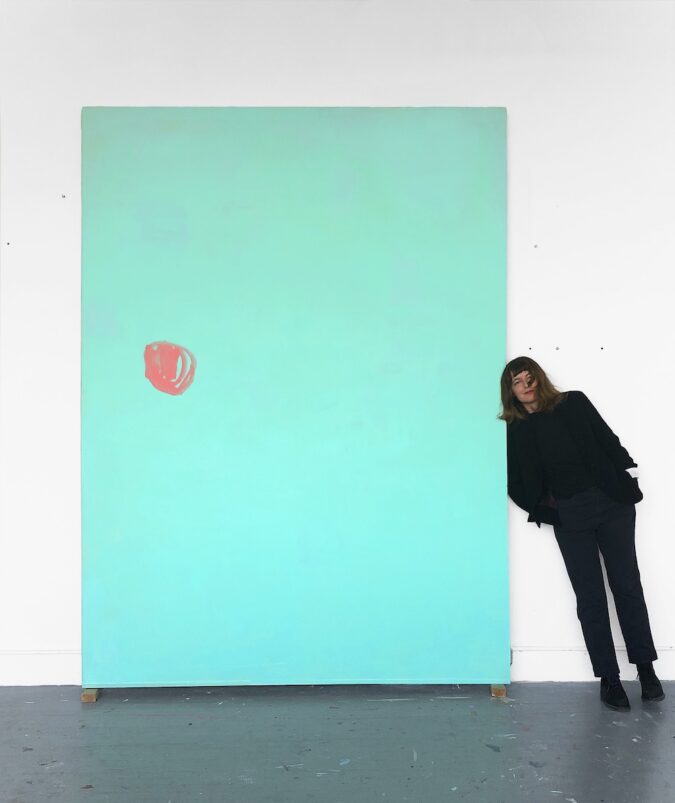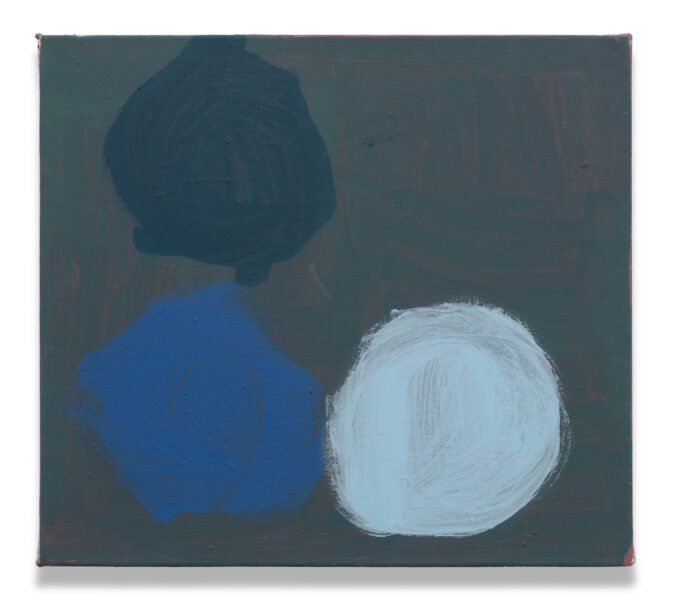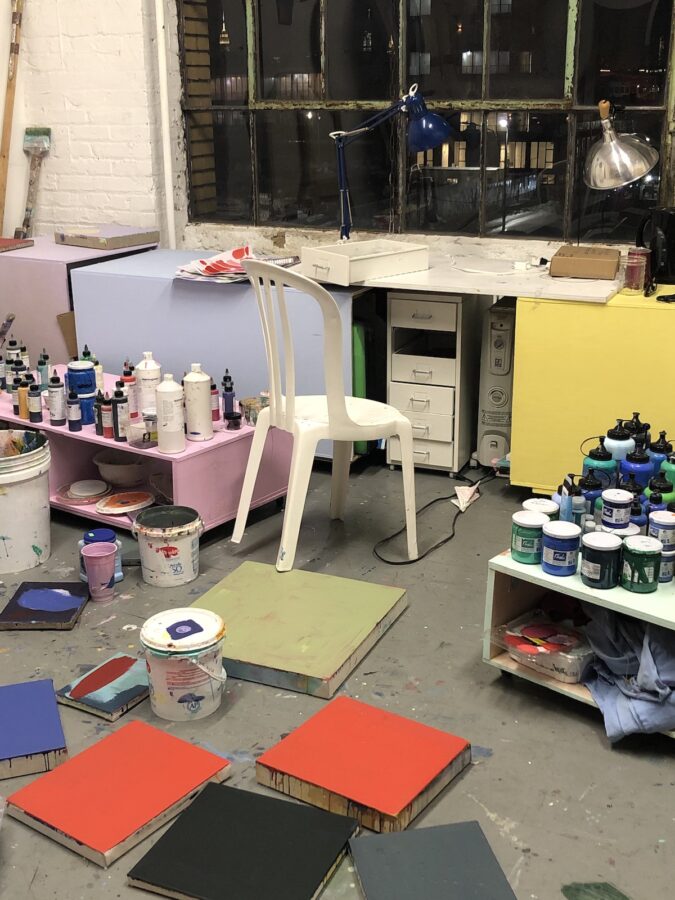Jule Korneffel
Jule Korneffel, born and raised in Germany, graduated from Kunstakademie Düsseldorf in 2008 as Meisterschüler under Tal R. In 2015 she moved to New York, where she feels the particular inspirations of Mary Heilmann and Agnes Martin. She graduated from the M.F.A. program at Hunter College in 2018. Recent shows include Phase Patterns at ltd los angeles, Here comes trouble at Spencer Brownstone in NYC, Mini Me Mary in Dialogue with Mary Heilmann at Albada Jelgersma Gallery in Amsterdam, and currently All that kale at Claas Reiss Gallery in London. In her exhibition All that kale with Claas Reiss in November 2020, A sun is the most recent and most reduced work with its one single mark on an ochre-ish ground. As in all her paintings, Korneffel imbued personal every day life experience into abstract language. ‘Suns are isolated and shine’ says Korneffel, referring to living in NYC during the Coronavirus pandemic.
Question:
“…yet within the melancholia is an unconditional sadness. And within the sadness is beauty. And within the beauty is longing. And within the longing is a plasma field of joy. Laughter within tragedy. Comedy, the possibility space of which tragedy is a rare form. Comedy, the genre of coexistence.”
Timothy Morton, Dark Ecology
I met Jule Korneffel several years after a curator introduced our works to each other. I saw her work first, at her New York City debut at Spencer Brownstone Gallery in March 2019, which is why I reached out to her, and we finally met. Her show enthralled me. It included paintings on canvas and one painting directly on the wall in the courtyard. I immediately felt the humor in her works. They appeared spontaneous and buoyant. The circular forms could be balloons lifting off the ground or falling to the earth. The physical touch in the paintings drew me into the layered color fields and gesturally formed circles. I needed to meet Jule.
We are now friends. During a late afternoon visit to Jule’s studio, our discussion turned to the color of twilight. We began to discuss the effect of light on her paintings and the idea of liminal time. To our surprise, we shared an interest in liminal characters as well, like the fool, clown, and trickster. Each of us has an attraction to imaginary selves. Humor is essential for both of us, and we shared the idea of laughter as a way of healing. Jule told me about a clown persona she invented several years ago when she enrolled in a clown workshop.
Being a clown requires a high level of risk and play in the performer. Jule, what are the connections between your work and your attraction to the clown? How does your clown persona’s performance reveal/reflect your practice of painting?
Answer:
“The moment you say my name, I’m gone – who am I?”1 is a riddle from the film2 Life is Beautiful (1998). It was written, directed, and starred in by Roberto Benigni, who says in the beginning that any fable is full of sorrows but also full of wonders and happiness3. Accordingly, a beautiful life entails both sides of the moon, laughter and sadness. Like this, my paintings come from living.

Jule Korneffel, “Still standing”, acrylic on canvas, 108 x 72 inch., 2020/ Courtesy of the artist. Photo: Daniel Greer
I first started to play clown improvisation theater after my father lost a long battle with cancer. But my clown had already arrived before then. I grew up with a poster and stories about the clown Charlie Rivel (1896-1983), who is best known for his loud inimitable cry of “UhHuu” issued with his head thrown towards the sky. I also have early memories of wearing my childhood clown costume as an everyday outfit – or at least parts of it. My mother dressed me funny too. She claims this was solely for practical reasons, because my big belly would make any regular pants drop. So she came up with cropped tights and suspenders, usually combined with knee-length striped stockings. When I was in the mood, I could entertain dinner guests with my funny stories, and theater was part of my life while in school.
In high school I didn’t get the role for Gretchen in our adaption of Goethe’s Faust, so instead the teacher wrote a cabaret-like role just for me. My first lines were: “I’m here because I didn’t get another role.” I could hear my mother laughing out loud in the audience: a long, high monotone scream, reminding me of Charlie Rivel. Still today, my mother thinks that this is my mantra for life: somewhat tragic but funny.
My clown persona’s characteristic thing was to try to measure the stage with her steps, but she never managed to get through this process. She tried and tried – even by trying to walk on her hands, though of course I can’t walk on my hands. It was a total disaster, and a lot of fun. Clown improvisation theater is a very vulnerable and risky field. The frustration level is brutal.
The development of my painting took techniques from my experience of improvising – such as starting out of blankness, uncountable trials to get a color and/ or mark right, and not knowing what the next step will be like. And I’m always ready to lose the entire painting. My studio is usually in the state of a “gleeful mayhem”4 like a clown’s mind. And, in both practices, emotions are the vehicle. Nothing but authenticity and integrity is of use. Also vulnerability and openness. I have to throw myself totally into this process of life and death. And as the clown and teacher Christopher Bayes says: “It’s more fun if you hit harder5.” Life can be like this too. I believe clowns are survivors and heroes.

Jule Korneffel, “You’ll be missed”, acrylic on canvas, 18 x 20 inch., 2021/ Courtesy of the artist. Photo: Daniel Greer
Mary-Lou, my clown persona, helped me with getting over my grieving. Her desperation about counting related to my father, who was a mathematician, and of our connection through numbers and abstract patterns. He and I communicated through them. Mary-Lou showed me a way through, and that death is not the termination of love. But also: that we can’t control life. It has its own rules we need to follow while playing along. That’s the magic of life, I believe. And the answer to the beginning riddle is “silence.”6
@jule_korneffel @jule.notes http://julekorneffel.com
1Life is Beautiful, directed by Roberto Benigni (1997; Italy, Melampo Cinematografica.)
2https://en.wikipedia.org/wiki/Life_Is_Beautiful wikipedia, March 14 2021.
The article further describes the venture and explosiveness of this film to combine the tragedy of the Jewish Holocaust by German National Socialism with humour.
3Ibid.
4Christopher Bayes with Virginia Scott Discovering the Clown or the Funny Book of Acting (Theatre Communications Group, Incorporated, 2019.)
5Ibid.
6Life is Beautiful, directed by Roberto Benigni (1997; Italy, Melampo Cinematografica.)






